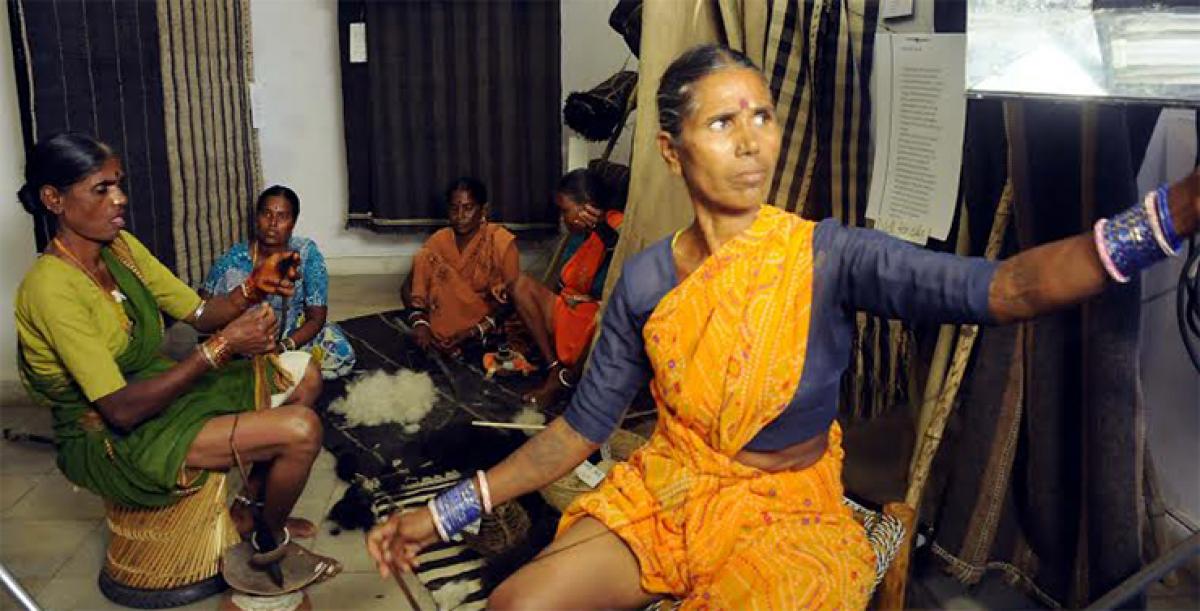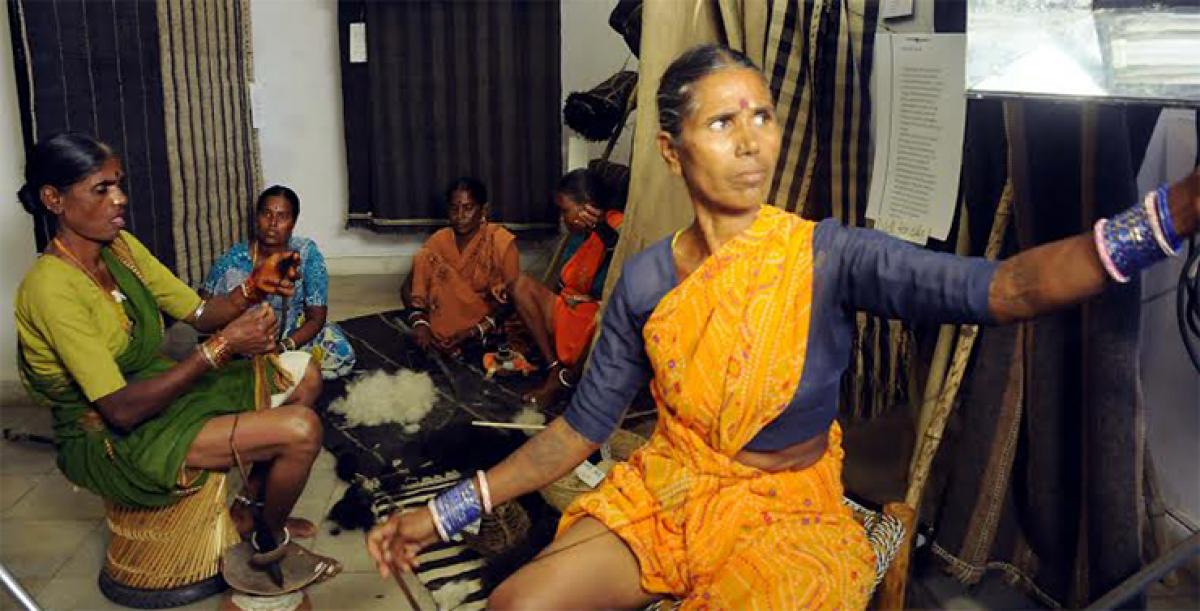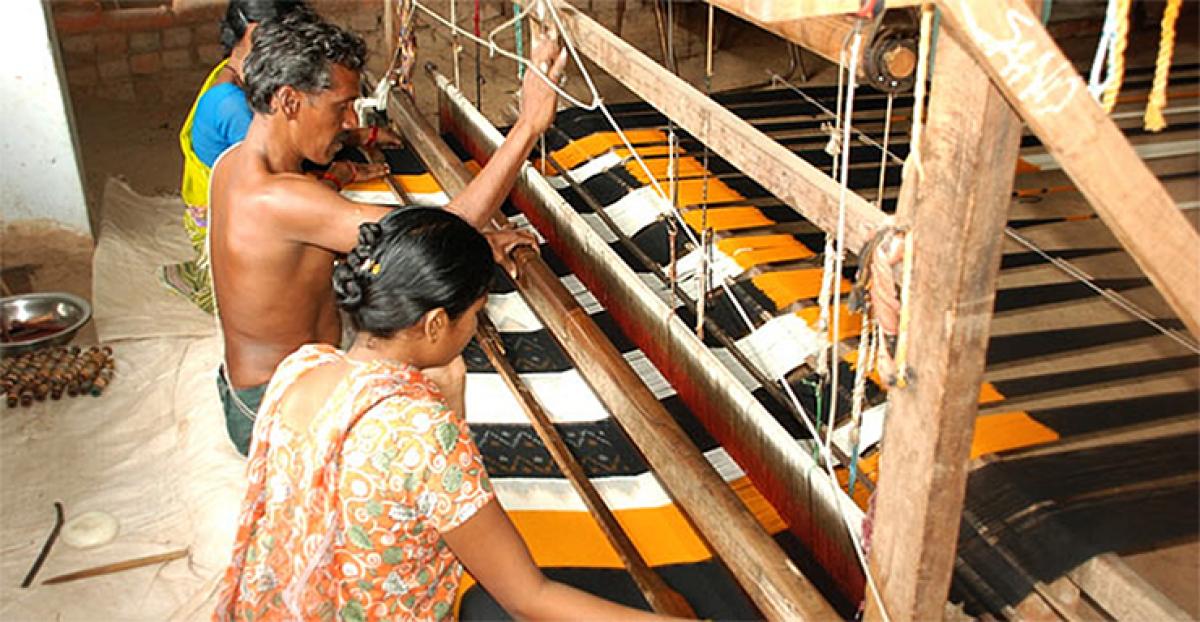Live
- Exit polls results indicated victory of the NDA government in Maharashtra and Jharkhand!
- Deputy CM Bhatti Vikramarka Reviews SC/ST Development Funds Implementation
- AP cabinet approves key decisions, check here
- Maharashtra records 58.22 pc turnout, Independent candidate dies of heart attack in Beed
- Manipur: Mobile internet suspension extended for 3 days in 7 districts, curfew relaxed in 4 districts
- EPFO adds 18.8 lakh members in September as employment rises
- ‘Criticise me, not Rabindranath Tagore’, says Assam CM on renaming Karimganj
- Bihar govt launches Ayushman Vandan Scheme
- Infighting again erupts in Trinamool on chair of West Bengal Medical Council
- Maha: Candidate, poll worker and voter die as skirmishes, stray violence mar peaceful voting
Just In

Imagine this; a woman spends her entire life as a weaver. She toils on a loom, working and living in adverse, unhealthy conditions; her wages never go up enough for her to sustain a decent life; at the end of a prolonged life of struggle, she ends up dissipated, defeated, sick with no healthcare or pension or even assured shelter and food.
Handlooms are the intangible heritage of India. However, experts warn that traditional designs are losing their exclusivity and there is an urgent need for patenting. Further, several issues like low wages, lack of healthcare, pension etc., continue to plague the weaver society

Imagine this; a woman spends her entire life as a weaver. She toils on a loom, working and living in adverse, unhealthy conditions; her wages never go up enough for her to sustain a decent life; at the end of a prolonged life of struggle, she ends up dissipated, defeated, sick with no healthcare or pension or even assured shelter and food.
Not hard to imagine since this is an old story. Of millions of workers across this country; a story that goes on across decades with little variation. No wonder then that the Government’s latest initiative – the ‘National Handloom Day’ – and all the proclamations about handloom being a tool to fight poverty are met with tired skepticism.
It has been a relentless battle for the handloom sector in India. “It is tragic that what you call as traditional issues facing handlooms continue to be the main issues still,” says Saraswati Kavula, activist, farmer and a force behind many initiatives to help handloom weavers. “Competition from power looms, low wages, high costs, lack of marketing facilities, lax policies still ail the handloom sector,” she laments.

“It is a cumulative effect,” says Dr D Narasimha Reddy, textile analyst and environmentalist. “The laws that protect handloom products from unfair competition are not enforced with diligence, institutional credit for handloom production has dwindled, input prices continue to rise and with government budget for handloom sector reduced, the situation has gone from bad to worse,” he shares.
It is estimated that the handloom sector contributes about 15 per cent to the total textile production. “Market demand for handloom sector has not diminished, even though handloom weavers are facing phenomenal problems. The contribution of handloom sector to national GDP and export earnings is substantial,” explains Dr Reddy.
According to the Ministry of Textiles, export earnings through handlooms have reached Rs 4,000 crore and it is estimated that a whopping 12.5 million people are employed in the sector, next highest to agriculture. According to an assessment by Centre for handloom information and policy advocacy CHIP, an institution set up for handloom promotion, India has more than 38,00,000 handlooms.
.jpg)
There are more than 15,00,000 domestic handlooms in north-eastern states. There were about 3,20,000 handlooms in unified Andhra Pradesh, on which directly 5,00,000 families and indirectly 20,00,000 families are dependent. All three regions of the erstwhile state have their own handloom textiles, with the chief centres being Dharmavaram, Emmiganur, Madhavaram, Chirala, Mangalagiri, Pedana, Ponduru, Polavaram, Pochamapalli, Puttapaka, Gadwal and Narayanpet.
Significantly, the handloom sector also forms the pulse point for many other income-generating services such as tourism and transportation. CHIP estimates that there are 32 other sectors including transportation, financial services, marketing services, service and maintenance services and hotels dependent on the handloom industry.
.jpg) The existing initiatives are not as effective as intended, says Mallesham, President, Shiv Shankar Silk Cheneta Sahakara Sangham of Pochampalli. Inventor of the famed Aasu machine that dramatically reduced the time taken in the whole weaving process, Mallesham says his stint as the president of a cooperative caused him disillusionment.
The existing initiatives are not as effective as intended, says Mallesham, President, Shiv Shankar Silk Cheneta Sahakara Sangham of Pochampalli. Inventor of the famed Aasu machine that dramatically reduced the time taken in the whole weaving process, Mallesham says his stint as the president of a cooperative caused him disillusionment.
“The cooperatives are useful in some ways but in their existing form, they are hardly beneficial for individual weavers,” he says. The Govt of India’s policy of clusters suffers from lacunae in implementation at the ground level and serves the interests of only the influential with no accountability, he says. Incidentally, the Prime Minister has on the occasion of the National Handloom Day proposed a quantum increase in the fund allocated to the handloom clusters from the present Rs 70 lakh to Rs 2 crore.
“There are multiple problems that dog handlooms. For decades, most handloom weavers never had any information access to various policies and schemes meant for their growth and benefit. On the other hand, government departments and implementing agencies do not have adequate information and data that would have helped in increasing the reach of the programmes and policies. There is a widening gap between policy formulation and implementation,” points out Dr Reddy.
Ignorance about the sector in the formal education system is another issue and Dr Reddy says that the weavers always found their own innovations whenever they faced an issue in production. Nevertheless, the fruits of technology failed to aid innovation in this sector. “Handloom weavers have been at the negative end of the changes wrought in by globalisation, consequent government policies and transient socio-economic conditions.
Governments at national and state level do retain several handloom schemes related to production inputs, market support and development, mainly parrying to electoral interests.” The problem is further compounded by powerful lobbying from the powerloom barons. “Unfair competition hits the sector again and again. It appears to be a major conspiracy and powerloom fabrics are passed off as handloom products,” says Saraswati Kavula.
As WTO diktats govern policies and markets are further opened up, the Indian textile sector has undergone major changes, but the positive developments failed to reap any benefits for the weavers, who still depend on their traditional wisdom and knowledge. What needs to be done? “There have to be better marketing opportunities and networks. The cost of the inputs has to be reduced.
The high costs of the handloom products are forbidding for the buyer. There should be no compromise in terms of procurement for government agencies such as APCO, and handloom should be handloom, not powerloom stuff passed off for handloom,” says Mallesham. He points to a recent, hopeful trend in Pochampalli, where Ikat weavers have come back to their traditional fold when NGOs helped them identify popular trends and demands in the market.
.jpg)
“We could regain some of our touch and successfully marketed our products when we were pointed in the right direction.” Mallesham emphasises on bringing information, guidance and skill development initiatives to the doorstep of the weaver. “A bridge needs to be built between us and the markets, through information-sharing and skill development. Subsidies are fine but are not enough by themselves or money gets misused,” he says.
“Despite an atmosphere of despair over its conditions, there are many consumers in India who would like to see the robust growth of handloom sector,” says Dr Narasimha Reddy. This sector should be the obvious choice for policy makers interested in reduction of negative impacts on environment and ecology and concept of sustainable development, he adds.
He offers succinct solutions for all the problems faced by the sector. “Raw material supply such as that of yarn, dyes and other things related to the production has to be made affordable and accessible. Hank yarn access should be improved. There have to be innovations in design with constant updates on consumer preferences. Weavers need incentives to adopt new methods and styles.
Institutions like NIFT adopted the traditional designs successfully but the reverse process did not happen,” he says. Dr Reddy also suggests enhancing retail networks, better markets, and revival of cooperative spinning mills, supplying yarn to handloom sector. And the government should establish low-cost, decentralised spinning units in the villages and major handloom centres.
Experts also warn that the traditional designs are losing their exclusivity and there is need for patenting designs. Reducing gender discrimination, especially in terms of wages, streamlining of cooperatives, enhanced budget allocations, strengthening of the various institutions working for handloom development, general social security schemes for weavers and their families are some of the other key suggestions that they make.
“The approach and policy of the government with regard to handloom sector in the last three years has been based on the recommendations of the Satyam Committee. Under rationalisation of textile policy and textile industry structure in Indian government, which is supposed to ‘strengthen the entire sector’ to face the international competition in the quota-free market in 2005, government has brought in deliberate policies to withdraw welfare schemes, and reduce budget allocations and actively promote power looms,” Dr Narasimha Reddy alleges.
Vasanta Sobha, Conservation Architect, who worked on the handloom towns in Andhra Pradesh for UNESCO, says, “Handloom tourism is an area that is not explored to its fullest potential.” Sobha suggests that organising handloom tours, taking people to the weavers on theme-based tours, will not only enhance tourism but also create more direct selling opportunities.
“The tendency is to protect and promote corporate interests. While the Government’s decision to announce a ‘National Day for Handloom is commendable, we should just hope that even this is not hijacked by the corporate entities,” says Saraswati Kavula. Handloom fabric is still the most preferred for the fashionistas of this nation.
But, as Saraswati points out, the multiplied cost of the fabric as it reaches the high-end customers who are happy to flaunt their magnificent silks and cottons, means little to the weavers, who still struggle with the paltry margins. And the women and men who weave the magical fabric stay where they have been for decades – the dark, obdurate corners of a hapless weaver’s house.
By:Usha Turaga-Revelli

© 2024 Hyderabad Media House Limited/The Hans India. All rights reserved. Powered by hocalwire.com







